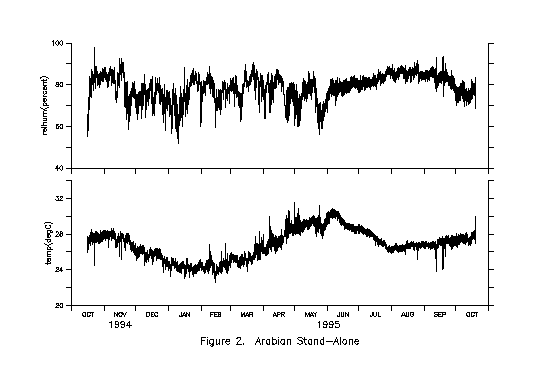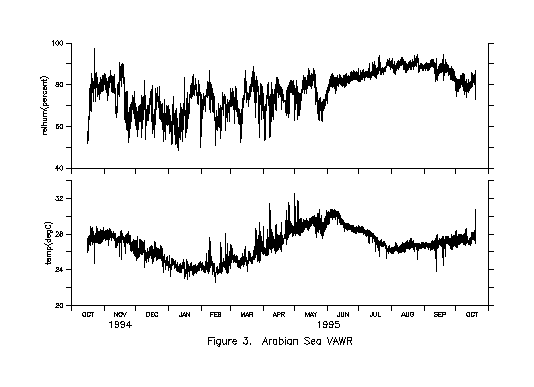

Recently the need has arisen for an inexpensive stand-alone self-powered logger to measure relative humidity and air temperature. There were several design considerations that needed to be addressed. Unlike the VAWR, the logger and battery had to be located in the same housing as the sensor for ease and simplicity of mounting on buoys. This, in turn, limited the battery size which, therefore, dictated the use of a reliable, low power sensor and logger. Finally, the accuracy of the data must be of the highest quality and comparable to that collected in past experiments.
The sensor chosen that best matched the aforementioned requirements was the Rotronics, MP-101A Relative Humidity sensor with air temperature probe. This is a low power device with high accuracy and proven reliability. The logger chosen was an Onset, Tattletale Model 4A (TT4A). The TT4A included a Memory and Timer (4MAT) board and a 512K Ram module for extended memory. The program used was written in Tattletale Basic and is easily modified to make changes in the sampling rate of the measured parameters. This type of Tattletale is also used in other UOP group instrumentation. The housing consists of a pressure case made from PVC pipe with two end caps made from PVC flat stock. There is a 6-pin watertight connector on the bottom endcap used for communications with the data logger. The sensor and sensor radiation shields are mounted on the top endcap. An aluminum rack is mounted to the inside of the top endcap to accommodate the logger and battery pack. The battery pack consists of ten Mallory MN1300 (D) cells in series, which should give a life of approximately 11 months depending on the sampling rate. There is also a small coin battery on the TT4A for memory backup in case of main battery failure. Figure 1 shows an overall view of the stand-alone logger.

The first deployment of a stand-alone unit was in the Arabian Sea experiment from October 94 to April 95. The second deployment in the Arabian Sea had a newly calibrated stand-alone unit from April 95 to October 95. One was also deployed on the GLOBEC (GLOBal ocean ECosystems dynamics) experiment off George's Banks from Dec. 94 to Aug. 95. Figure 2 shows a time series plot of relative humidity and temperature data from the the Arabian Sea stand-alones. For comparison purposes, figure 3 shows a time series of relative humidity and temperature collected by the VAWRs deployed on the same buoys in the Arabian Sea.


The reliability displayed by this type of logger has led to more units being planned for future experiments. In addition another stand-alone unit is being developed to measure precipitation on buoys. The UOP group is also planning on interfacing an AIR relative humidity and air temperature sensor to this type of logger for the upcoming Coastal Mixing experiment. Development and testing of new sensors and data loggers are an ongoing commitment for the UOP group.
Several people deserve thanks for their assistance: Dick Payne for his experience and help in evaluating various sensors and calibration of the stand-alones, and Nancy Brink who processed the stand-alone data and plots that are used in the technical note. This work was supported by the Office of Naval Research Grant No. N00014-94-1-0161.
Bryan S. Way is a Senior Engineering Assistant in the Physical Oceanography Department and a member of the Upper Oceans Processes Group at the Woods Hole Oceanographic Institution.
 Return to UOP Homepage
Return to UOP Homepage